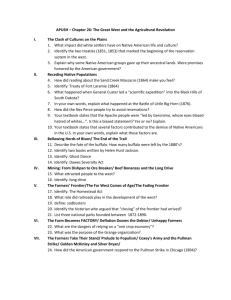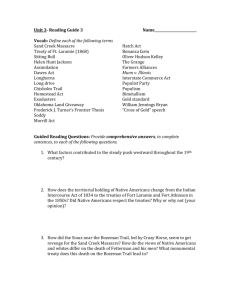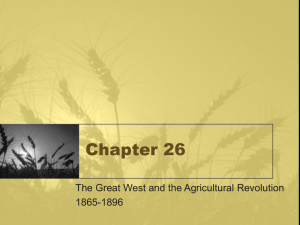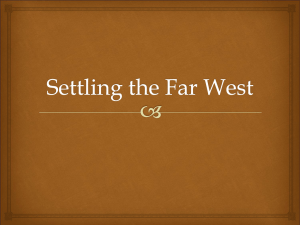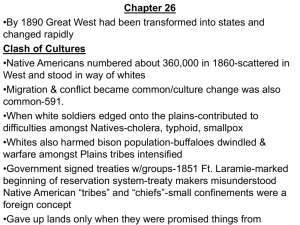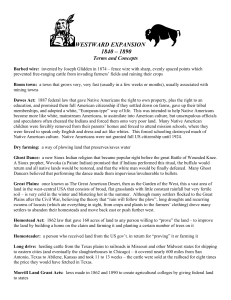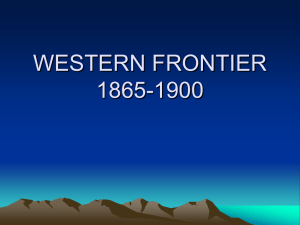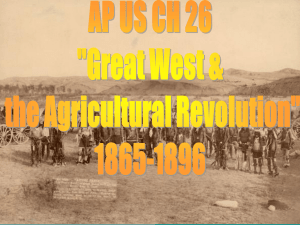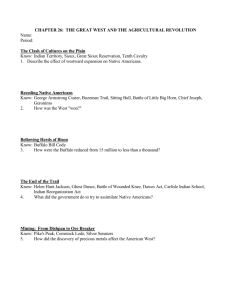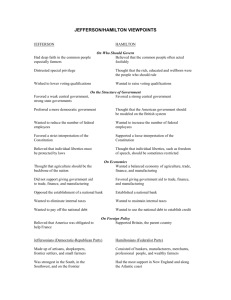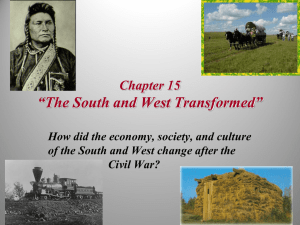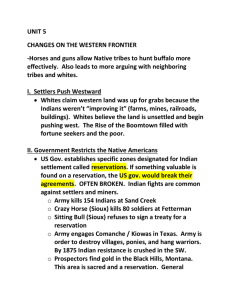The Last West and the New South, 1865-1900
advertisement
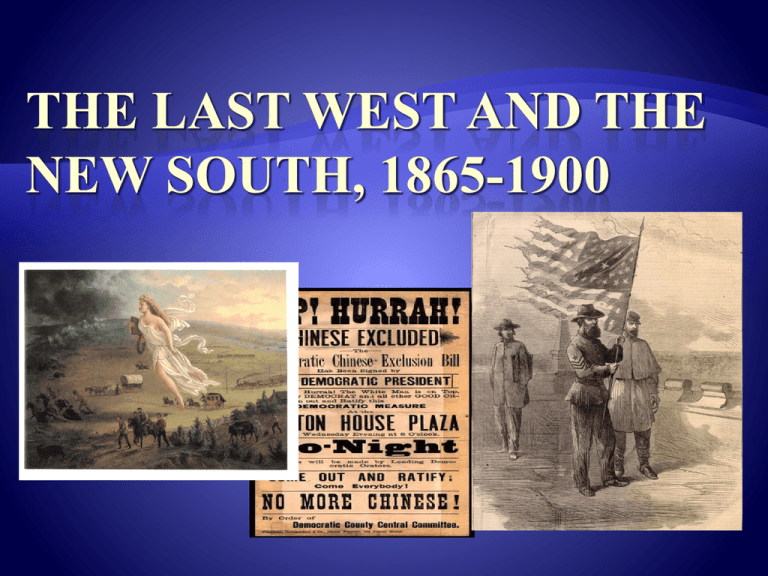
American social development has been continually beginning over again on the Frontier. This perennial rebirth, this fluidity of American life, this expansion westward with its new opportunities, its continuous touch with the simplicity of primitive society, furnish the forces dominating American character. The true point of view in the history of this nation is not the Atlantic coast, it is the Great West. - Frederick Jackson Turner, 1893 Louisiana Purchase (1803) Lewis & Clark Expedition (1804-1806) Mexican-American War (1846-1848) Manifest Destiny – no more Concentration is on war Postbellum Period People begin to move West Known as the “Great Desert” 1900 – Heavily inhabited Buffalo population is down by 95% Railroads choking out Native American lands Groups of Settlers: Miners Cattlemen Farmers Miners Gold Rush – 1848 Settled much of CA and OR Colorado Pike’s Peak – 1859 100,000 inhabitants Nevada Comstock Lode (1864) Speculators Placer mining Deep-shaft mining Investment and capital Boomtowns Virginia City, NV San Francisco, CA Sacramento, CA Denver, CO Problems in CA: Immigration – mostly Asian Miner’s Tax $20/mo ALL foreign-born miners Chinese Exclusion Act of 1882 Eliminated immigration from China Renewed in 1892 The Cattle Frontier Economic opportunities Railroad Postwar – opened up East to the West Cow Towns Abilene, TX Dodge City, KS Chicago, IL “Long-Drive” Chisholm Trail Goodnight Loving Trail Conditions: Workers Mexican immigrants/blacks (exodusters) $1.00/day Farming/grazing methods 1880s – overgrazing 1885-1886 – massive drought Killed 90% of cattle on Plains Privatization of property Joseph Glidden (1874) The Farming Frontier Homestead Act of 1862 160 acres 500,000 moved west 2.5 million had to buy land from RRs Problems: No building materials Extreme hot and cold No water Solutions: Sodbusters – sod bricks “Dry farming” Russian Wheat “Hurrah for Greer County! The land of the free, The land of the bedbug, grasshopper, and flea; I’ll sing of its praises, I’ll tell of its fame; While starving to death on my government claim.” Antebellum: “one big reservation” “Indian Country” – government nomenclature 1834 – Indian Intercourse Act Whites must have a “license” to move to the West Changes in 1848 Removal of Native Americans 65% live on Great Plains Tribes: Sioux Blackfoot Cheyenne Crow Comanche Conflicts with U.S. Govt. Reservation Policy Used to open terrain Settlers moved West Transcontinental RR being built Native American philosophies: Family NO Private Property U.S. government attitude towards indigenous: Reservations! Treaty of Fort Laramie (1851/1868) Indian Wars November 1864 – Massacre at Sand Creek John Chivington “Nits make lice” 1867 – Great Sioux War 7th Cavalry loses big! Battle of Little Bighorn Col. George A. Custer Custer’s Last Stand “Assimilationists” Respond Dawes Act (1887) Wanted Native Americans to assimilate Give up Ghost Dance Become “civilized” U.S. Govt. divides up tribal lands 47 million acres FAILURE Battle of Wounded Knee December 28, 1890 Wounded Knee Creek, SD 7th Cavalry – rounds up 350 starving Sioux Demand Sioux to give up weapons Last of the Indian Wars Frederick Jackson Turner “The Significance of the Frontier in American History” (1893) Argument: Frontier played a significant role in forming American identity Individualism and ruggedness West was a safety valve for East By 1890 – West was closed In your opinion, was Reconstruction a success or a failure? Did southerners receive a “New South” or was it the same old “Reconstruction South”? In your answer be sure to discuss social, political, and economic issues that “Reconstructionists” faced during this time period. With the people around you, identify: What this document is saying about the South? How does the document describe the conditions in the South (social/cultural, economic, and political)? Does this document exhibit or demonstrate the potential for a New South or is it just the Reconstruction South? Still recovering from Civil War Henry Grady Pro-industrialization Pro-transcontinental RR Atlanta Constitution article Economic Process Cities Birmingham, AL Major symbol of “New South” Steel center Richmond, VA Tobacco center Memphis, TN Lumber capitol CHEAP LABOR! Textile industry Georgia, SC, and NC Made more cloth and textiles than New England 1865 – 12 small cotton mills 1900 – 400 cotton mills 100,000 workers Continued Poverty Mostly agriculture Poorest region in the country Northern investors controlled ¾ of RRs Money went to bankers and to the North – not Southerners Poverty caused by: Late entry into industrialization Poorly educated work force Agriculture Cotton prices drop drastically Farmers lost lands Per capita income declined By 1900 – 50% of whites were tenant farmers – 75% blacks George Washington Carver Farmers Unite! 1890 – Farmers’ Southern Alliance 1 million members Colored Farmers’ Southern Alliance 250,000 members Both wanted political and economic reforms Poor whites and black united for a common goal Segregation 1877 – Federal troops exit South No more protection for blacks Democrats come into local power White supremacy Separate races KKK Plessy v. Ferguson (1896) Jim Crow Laws Grandfather clause Poll tax Literacy tests Voting numbers fall Louisiana 1896 – 130,334 1904 – 1,342
